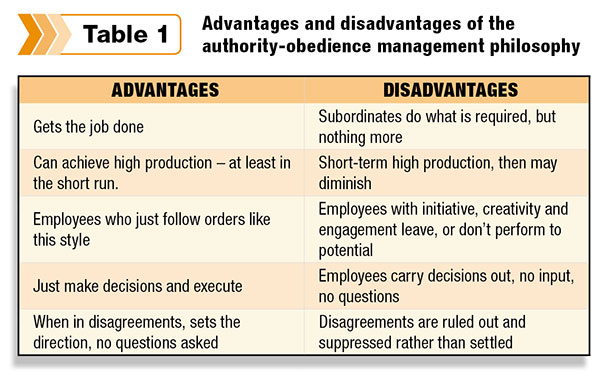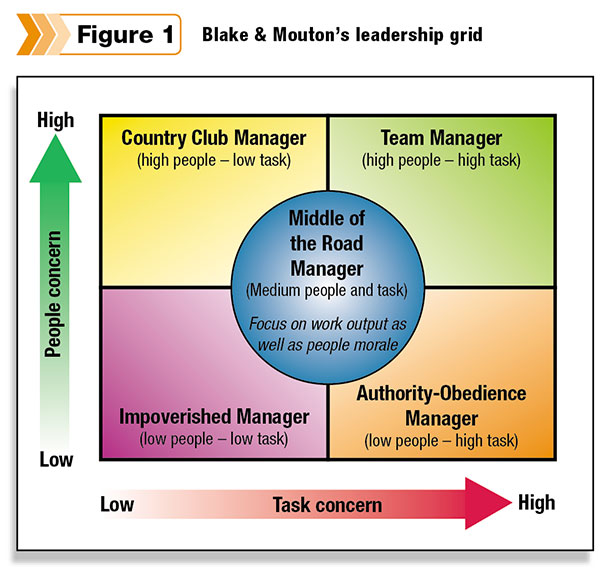Dan comes into the milking parlor. The members of his five-person milking team are all standing around in the middle of the parlor. Dan fumes and comes down the hall yelling, “Get back to milking, we are going to be late! What are you doing standing there doing nothing?”
Remember Dan from our last article on management philosophies? You might remember Dan’s philosophy: His highest concern is for the task; his style’s key philosophies are to measure, to monitor – maybe even micromanage. The basic assumption (which plays in this scenario) in this style is that the worker, given an opportunity, will prefer to do something else other than the work.
As usual, in the above scenario, Dan assumes the worst before even finding out what is really going on – he comes down on the group. “We are here to work; the work needs to be done. If you are working hard enough, you shouldn’t have time to feel unhappy. You are not here to enjoy yourselves, after all.”
As he comes closer, he notices sorrow on everyone’s faces. One of the milkers is crying. The shift leader turns to Dan and says, “Patrón, Pedro’s mother just died in a terrible car accident in Mexico. He is not able to go see her.” Dan’s heart sinks.
Why do managers have to have these type of wake-up calls to some of the negative effects of their management style? What would Dan have done differently if he’d had the slightest idea what was going on?
Managers with an authority-obedience philosophy toward people can come across as insensitive, micromanaging, focused only on tasks assigned/completed, etc. However, the purpose of this article is not to hammer this philosophy or style of management. What you focus on gets most of your energy – and getting cows milked, fed and bred are critical daily tasks. Let’s look at some of the advantages and disadvantages of this philosophy or management style ( Table 1 ).
Effective leadership
Using an authority-obedience philosophy has definitely gotten you somewhere, but not with every situation, and if what you want is to improve your leadership, flexing your style and not being so rigid will be a great start to a more effective leadership ( Figure 1 ).
Become a metacognitive manager
Metacognition is often referred to as “thinking about thinking” or being aware of your own thinking. And since thoughts lead to emotions and actions, it is important to become self-aware, particularly when it impacts our management philosophy. Metacognition is a regulatory system that helps a person understand and control his or her own cognitive performance.
Thinking about your own thinking allows you to take charge of your own learning. In the previous example of Dan walking into the parlor, when he did that and saw milkers just standing around, he might have observed and investigated what is going on (and have become aware of himself) before coming down on people.
What about trust?
The authority-obedience manager’s focus on concern for the task makes them have lower focus on people and therefore have a hard time establishing trust with people. This style of manager at least needs to look around and work on key relationships with those around them. In a world where measuring and impacting employee engagement has become top priority, establishing trust, at least at a basic level, will pay big dividends.
Others can solve problems, too
When your management philosophy is based on authority, your tendency will be to solve problems yourself, tell people and expect them to obey you and do as you say. That works, no question – but not in every situation. One challenge is that as dairy organizations have gotten bigger, people at every level of the organization need to solve problems at their own level, leaving you the biggest problems to solve.
This makes the system more efficient, with you being less of a fire-engine-type manager. Building trust with those key people around you is fundamental in teaching them and then letting them solve their own problems. The fundamental ability you need to have at all times is being able to decide what problems can and should be solved by others and which ones need to be solved by you.
Letting decisionsbe made at every level
The authority-obedience manager generally is driven by making decisions, large and small, and loves being in charge. Just decide and tell them what to do, and it will all be fine. Well, not quite that way. In bigger and more dynamic dairy organizations, that can actually be detrimental.
For example, the manager who can’t develop trust, then train and delegate problem-solving and decision-making, can actually stall parts of the system – or all of it. As you become more self-aware, notice what decisions are on the table, which people in your team are capable, and trust them and communicate to them what your expectations are about those decisions. Then focus on the bigger decisions in your court.
Body language and tone of voice
Body language, tone of voice and facial expressions in conjunction account for 85 to 90 percent of how we communicate. Part of the authority-obedience manager’s self-awareness starts there: noticing oneself and the impact on others. You know how it goes: It is not just what you say but how you say it and the impact it has on others.
Develop empathy
In its most basic definition, empathy is the capacity to understand what another person is experiencing from within the other person’s frame of reference or the capacity to put yourself in another person’s shoes. Leaders today are rated high on producing engagement in employees when they develop a positive emotional connection, which starts with caring about the other person and what they are going through.
Coaching the authority-obedience manager
Let’s get something clear off the bat. When you hear someone say, “Come over here; let me coach you on this or that,” beware. It may mean the person wants to tell you what to do and how to do it. That is not coaching; that is advising, telling, recommending.
Coaching, on the other hand, is working with a person so they imagine and envision an ideal future, find answers to their own problems and situations, and establish a plan of action toward that future. It is having the person draw on their experiences, wisdom and imagination for thinking, behaving and feeling a different way, a new way, that will make them more effective.
Having said that, coaching the authority-obedience manager can be a challenge. In my experience, they are managers who have a hard time being introspective about themselves, reflective about themselves and their behaviors (using metacognition).
The fundamental work of coaching this manager starts with helping them become aware of their ways of thinking, actions and even feelings. Then evaluate the impact those have on their performance as leaders and move to producing changes that will improve their behavior and leadership.
Conclusion
As we mentioned before, becoming aware of your own management philosophy is the first step. Be willing and open to building closer relationships and trust with your key people; this will impact how you delegate problem-solving and decision-making to your employees, empowering them to be more engaged in their work. Be open to learning and flexible to new management styles that support different situations in order to become a more effective leader. PD
ILLUSTRATION: Illustration by Corey Lewis .

-
Jorge Estrada
- Leadership Coaching International Inc.
- Email Jorge Estrada








